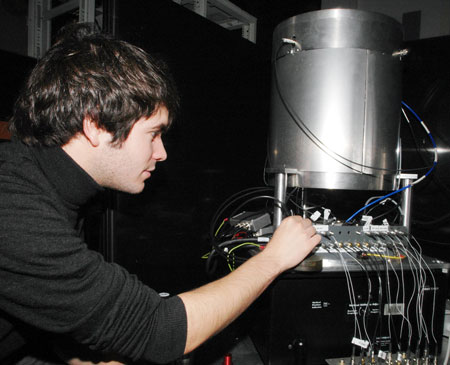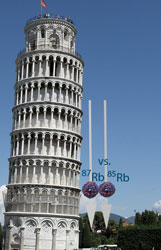Onera, already recognized as an expert in the spatial macroscopic measurement of the equivalence principle (MICROSCOPE) has just made an important advancement in terms of atomic scale measurement to test this cornerstone of physics.
Onera’s physicists have succeeded in achieving the simultaneous measurement – by matter-wave interferometry1 – of the acceleration of two rubidium isotopes (85Rb and 87Rb) in free fall, whose properties are very similar but with slightly different atomic compositions. This result was artfully obtained fairly quickly, using an embeddable gravimeter previously developed by Onera. This successful experiment was conducted as part of the thesis of Alexis Bonnin.

Alexis Bonnin, Onera PhD student, connects the last lasers of the gravimeter for the compared measurement of the accelerations of the cold rubidium atoms
This world premiere marks a very encouraging development in the context of differential experiments in space, dedicated to testing the equivalence principle2 at the atomic scale.
An experiment of this type is also envisaged within the framework of the ESA project STE-QUEST, which brings together around thirty European laboratories on the subject of the link between general relativity3 and quantum physics4 (two major theories of physics lacking unification).
In addition to the benefits for fundamental physics, this success reinforces ONERA’s expertise in embeddable atomic gravimetry because it uses the same technology based on cold atoms and sturdy lasers.
Notes
-
Matter-wave interferometers or atom interferometers make use of the wave nature of matter. The wave-particle duality principle postulates that a wave packet (known as a DeBroglie wave), which can be treated in a similar way to light waves in optics, can be associated to all massive particles. For example, it is possible to split them into two or to make them interfere.

-
The equivalence principle postulates the equivalence of gravitational and inertial mass. This principle is equivalent to that of the universality of the falling of bodies stated by Galileo in 1602: “All bodies, feathers like lead, obey the same law of fall”. This principle has so far never been disproved. However, physicists seek tiny differences that could validate unified theories in physics, such as string theory.
-
General relativity can describe the behavior of objects that are massive – like stars and black holes - and fast – with speeds close to that of light - and thus address many questions in astrophysics and cosmology. General relativity – the gravitation theory - has never been disproved (but it could be, if the equivalence principle does not hold true in some future experiments).
-
Quantum physics describes the invisible world of atoms, electrons and molecules. It introduces basic concepts such as wave-particle duality, Heisenberg’s uncertainty relations and the Schrödinger wave function. Without quantum physics, there would be no lasers, or transistors, or flat screens.




